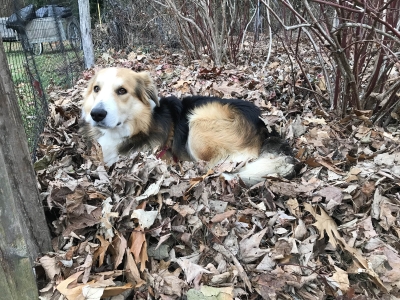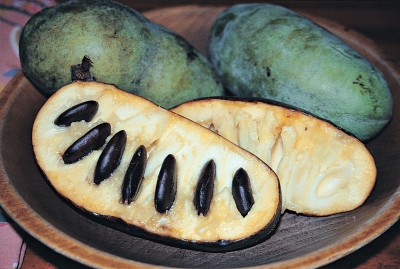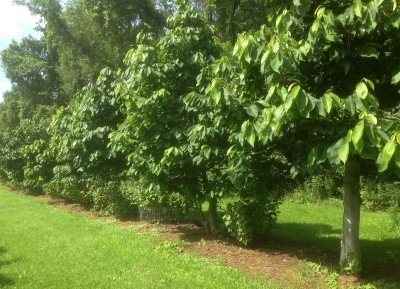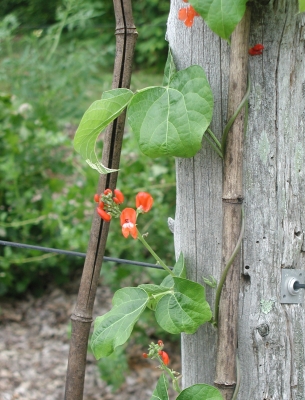Some Fruits and a Ornamental Veggie
Happy Blueberries, Happy Me
My sixteen blueberry plants make me happy, so I make them happy. (They made me happy this year to the tune of 190 quarts of berries, half of which are in the freezer.) I don’t know how much work bearing all those berries was for them, but I just finished my annual fall ritual of lugging bag upon bag of leaves over to the berry patch to spread beneath the whole 750 square foot planted area.

I don’t begin this ritual spreading until the blueberries’ leaves drop. Then, old leaves and dried up, old fruits are on the ground and get buried beneath the mulch, preventing any disease spores lurking in these fallen leaves or fruits from lofting back up into the plants next spring. Rainy, overcast summers or hot, dry summers or any weather in between — my bushes have never had any disease problems.
In past years, I did do two things before spreading that mulch. First, I spread some nitrogen fertilizer: my universal pabulum, soybean meal, at the rate of 2 pounds per hundred square feet. And second, I spread some sulfur, at about the same rate, to keep the soil acidic. After many years of mulching, the soil has built up an ample reserve of organic nitrogen — evidenced by the plants’ 2 to 4 feet of new stem growth each year. So I no longer add extra nitrogen.
With all those years of mulching, levels of decomposed and decomposing soil organic matter have greatly increased the soil’s buffering capacity for acidity. That means that I no longer have to pay such close attention to acidity, so I rarely add sulfur anymore.

Sammy also likes the mulch
Besides all these other benefit, the mulch has created a soft root run that retains moisture, just what blueberries’ thin roots really like. Fruit is borne on shoots that grew the previous season, so each year’s vigorous new growth translates into a good crop in the offing for the next year.
New York Bananas
Although the crop seemed paltry at first this year, by the time autumn came around, pawpaws were in abundance. This uncommon fruit is the northernmost member of the tropical custard apple family, and the fruit does indeed taste very tropical — a flavor mix of banana, mango, avocado, and vanilla custard — even though it’s easy to grow and native throughout much of the eastern U.S..

Two trees would be adequate for most households; I have about 20, just so I can learn more about them and their individual differences. That makes for a lot of pawpaws! (I test market most of them.)

Pawpaw fruits are very variable in both size and flavor even among the branches of a single tree. One year, I tried thinning the fruits to see if that would increase size of remaining fruits, as it does with apples and peaches. Pawpaw has a multiple ovary so each blossom can give rise to as many as 9 fruits. The small fruits are hard to see because they match so closely the green color of the leaves, so I didn’t thin as many as I had hoped. That said, at season’s end, fruits on thinned clusters seemed no larger than fruits on unthinned clusters.
Beginning around the middle of September, I began harvesting the first fruits. I picked some up from the ground and picked some softening ones from the trees, all of which continued through October. By putting them immediately in a cooler at 40°F, I still had good fruit into the middle of November.
Scarlet Runners
Every year I fear that at season’s end I’ll remember something I forgot to plant. This year it was scarlet runner beans.

Despite the “bean” in the name, I’ve grown this vining bean, as do most people, primarily as an ornamental, for its scarlet blossoms. I occasionally eat the fat, hairy, yet delectable green beans.
Every year I collect some of the matured black and pale purple, calico seeds for replanting the following year. One year, I decided to cook up some of these seeds and taste them. Scarlet runner bean seeds are quite tasty (and, I learned prior to eating, nonpoisonous).

Next year I’ll remember the scarlet runners. My yard will be aflame in scarlet flowers and, because the plant is pest-free — even to Mexican bean beetles — I expect to reap a bumper crop of beans.



Timely post – we hope to be planting blueberries next spring. Thanks for the info.
You’re inspiring me to try blueberries.
Hi I have some runners or shoots coming up about 2 feet from my paw paw, can these be used to start a new tree? thanks
Generally, no. They are still very dependent on the the mother plant, to which they are connected. You might try digging around some of the shoots one year and then digging them up to move the next year. If you have a grafted tree, the shoots will be genetically the same as the seedling rootstock, not the grafted variety.
Ah, I guess my blueberry bush did so well this year due to all the rain we had! My neighbor just planted some Paw Paws. It will be interesting to see if they survive since we garden in zone 4. I love scarlet runner beans for the hummingbirds! I never seem to pick the beans at just the right time when they’re delicious but I sure will try some seeds now that you mention it!
Pawpaw should survive in Zone 4. What might be limiting is the amount of heat and the length of the growing season. Then again, it gets pretty hot in Wisconsin summers!
Testing the comment section on Microsoft Edge.
Thanks. It worked!
Our very old blueberry bushes have some kind of decease these last 2 years. The fruit gets soft and mushy . Do you have some advise for us? ( zone 5)
Thank you,
Carla
It could be blueberry maggot or spotted wing drosophila, both insects.The maggots can be controlled by setting out traps that are nothing more than red spheres coated with Tangletrap, a commercially available goo that stays sticky. It’s the same kind of trap used to trap apple maggot flies. For the drosophila, see my blog post https://leereich.com/2015/07/blueberries-galore-compost-tea-redux.html (and some others). Traps are under development for this pest also, so stay tuned.
Thank you for the advise . I will fallow it and hopefully see some improvement.
Carla Z.
Here in Anaheim I have had good luck with my highbush blueberry planes. High temps in 90s & keeping them moist.
Now I have used my urine diluted with H2o, and seen Hugh growth and lots of berries.
Same with my Fig tree.
Hi Lee,
Curious about your blueberry spacing (I’ve seen recs from 4 feet up to 7 feet in row, quite a range). I attempted some math– 16 plants in 750 sq feet, does that put them at 5 feet in row spacing, 8 feet between row spacing? Thanks for any advice.
That is about right for my spacing. My bushes, however, grow very vigorously, often putting 2-3 feet, sometimes more, of new growth each year. This makes for good yields but is difficult to manage at that close spacing. I do mulch and never add fertilizer (although I used to fertilize) in the hopes of slowing down new growth.